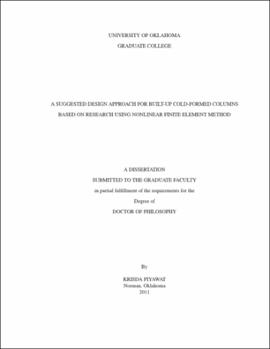| dc.contributor.advisor | Ramseyer, Dr. Chris C.E. | |
| dc.creator | Piyawat, Krisda | |
| dc.date.accessioned | 2019-04-27T21:27:43Z | |
| dc.date.available | 2019-04-27T21:27:43Z | |
| dc.date.issued | 2011 | |
| dc.identifier | 99208966802042 | |
| dc.identifier.uri | https://hdl.handle.net/11244/318747 | |
| dc.description.abstract | A deficiency of the 2007 AISI specification, Sections C4 and D1.2 for built-up, coldformed | |
| dc.description.abstract | members under pure compression is experimentally identified. The AISI specification | |
| dc.description.abstract | is found to be exceedingly conservative, especially for distortional-buckling members | |
| dc.description.abstract | with a larger cross section and a longer length. By using sequential batch-feeding, | |
| dc.description.abstract | nearly a thousand nonlinear-buckling finite element simulations of built-up, cold-formed | |
| dc.description.abstract | sections are carried out to validate the model prior to experimental work, identify the extent | |
| dc.description.abstract | of the deficiency, and rectify the deficiency. In all, a simpler less-conservative design | |
| dc.description.abstract | equation for cold-formed built-up members prone to distortional buckling is proposed in | |
| dc.description.abstract | this two-phase work. | |
| dc.description.abstract | In Phase I, highly-nonlinear, finite-element models and a state-of-the-art modeling | |
| dc.description.abstract | strategy are used to validate and verify the geometrically unstable built-up compression | |
| dc.description.abstract | members which exhibit a variety of buckling behaviors. The finite element program ANSYS | |
| dc.description.abstract | is used to validate over 265 experimental tests, while the use of the finite element | |
| dc.description.abstract | program ABAQUS is used to verify the ANSYS results. Two totally different numerical | |
| dc.description.abstract | schemes of implicit-static and explicit-dynamic under various iterative and non-iterative | |
| dc.description.abstract | solution techniques, which include Newton-Raphson, Arc-Length, Riks, and Central- | |
| dc.description.abstract | Difference integration methods, are converged toward identical solutions. A structural | |
| dc.description.abstract | solid (brick) element is thoroughly examined and compared with a structural shell element | |
| dc.description.abstract | (most commonly used in the modeling discipline for thin-walled structures) which | |
| dc.description.abstract | provides advantages in: (1) advancing through a critical buckling state, (2) tracing a softening | |
| dc.description.abstract | response of the post-buckling regime, and (3) assuring the modeling of a true structural | |
| dc.description.abstract | failure (not a numerically induced one). | |
| dc.description.abstract | In Phase II, a parametric study of an additional 360 cold-formed built-up compression | |
| dc.description.abstract | members are modeled to investigate new structural built-up configurations. The AISI | |
| dc.description.abstract | specification flexural provision is applied in conjunction with the slenderness modification | |
| dc.description.abstract | and the code predictions are compared to the results of the analytical models. A proposed design equation is developed based on a regression analysis of a three-dimensional | |
| dc.description.abstract | surface fitting. The proposed equation corrects the deficiency of the distortional provision. | |
| dc.description.abstract | An evaluation of the proposed design equation shows good agreement with the | |
| dc.description.abstract | experimentally measured capacities. | |
| dc.format.extent | 268 pages | |
| dc.format.medium | application.pdf | |
| dc.language | en_US | |
| dc.relation.requires | Adobe Acrobat Reader | |
| dc.subject | Steel--Cold working | |
| dc.subject | Buckling (Mechanics) | |
| dc.subject | Strains and stresses | |
| dc.subject | Finite element method | |
| dc.subject | Nonlinear theories | |
| dc.title | A SUGGESTED DESIGN APPROACH FOR BUILT-UP COLD-FORMED COLUMNS BASED ON RESEARCH USING NONLINEAR FINITE ELEMENT METHOD | |
| dc.type | text | |
| dc.type | document | |
| dc.thesis.degree | Ph.D. | |
| ou.group | College of Engineering::School of Civil Engineering and Environmental Science | |
